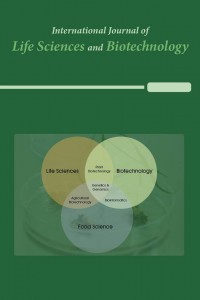Lahanagil Sebze Türlerinin Kök Sistemi Mimarileri Yönünden Karşılaştırılması
Brassica, kök, fenotipik çeşitlilik, korelasyon
Comparison of Brassica Vegetables in terms of Root System Architectures
Brassica, root, phenotypic diversity, correlation,
___
- 1. Balkaya, A., O. Karaağaç, and S. Atasoy, Geçmişten Geleceğe Türkiye'de Lahanagil Sebzelerinin Üretimi, Sorunları ve Çözüm Önerileri, in Farklı Yönleriyle Lahanagiller Üzerine Bilimsel Çalışmalar, F. Yaşar and Ö. Üzal, Editors. 2023, İksad Publishing House. Türkiye. p. 3-36.
- 2. Ekinci, M., S. Örs and E. Yıldırım, Lahanagil Sebze Türlerinde Sulama ve Su Stresi, in Farklı Yönleriyle Lahanagiller Üzerine Bilimsel Çalışmalar, F. Yaşar and Ö. Üzal, Editors. 2023, İksad Publishing House. Türkiye. p. 181-214.
- 3. Balkaya, A., “Bahçe Tarımı-II. Ünite 7. Lahana, Karnabahar, Brokoli, Yetiştiriciliği”. II. Basım, 2016. Anadolu Üniversitesi Yayını No:2358. Açık Öğretim Fakültesi Yayını No:1355.
- 4. Kasım, M.U., and N. Sürmeli. Brüksel lahanası yetiştiriciliği. Atatürk Bahçe Kültürleri Merkez Araştırma Enstitüsü, 2003. Yayın No: 87, Yalova p. 19.
- 5. Murat Doğru, Ş., and A. Çilingir, A. Balkaya, Brokoli yetiştiriciliği. Tarım Gündem, 2016. 6 (34): p. 20-24.
- 6. Bektaş, H., The effect of salt stress on root development and architecture in common grass pea (Lathyrus sativus L.). Avrupa Bilim ve Teknoloji Dergisi, 2021. 23: p. 793-799.
- 7. Kandemir, D., et al., Kıvırcık ve yedikule tipi marul çeşitlerinin kök gelişimi ve kök sistemi mimarisi yönünden incelenmesi. Manas Journal of Agriculture Veterinary and Life Sciences, 2021. 11(2): p. 120-130.
- 8. Hanson, B.R., D.M. May, and L.J. Schwankl, Effect of ırrigation frequency on subsurface drip ırrigated vegetables, 2003. Department of Land, Air and Water Resources, University of California, Davis, CA.
- 9. Adeniran, K.A., et al., Water requirements of some selected crops in kampe dam irrigation project. Australian Journal of Agricultural Engineering, 2010. p. 119-125.
- 10. Bahadur, A., et al., Physiological and biochemical basis of drought tolerance in vegetables. Vegetable Science, 2011. 38 (1): p. 1-16.
- 11. Bute, A., et al., The most suitable irrigation methods in cabbage crops (Brassica oleracea L. var. capitata): A review. Scientific Papers. Series B. Horticulture, 2021. 65(1): p. 399-405.
- 12. Jung, J. K., and S. McCouch, Getting to the roots of it: genetic and hormonal control of root architecture. Frontiers in Plant Science, 2013. 186(4): p. 1-32.
- 13. Lopez-Bucio, J., and A. Cruz-Ramirez, L. Herrera-Estella, The role of nutrient availability in regulating root architecture. Current Opinion in Plant Biology, 2003. 6: p. 280-287.
- 14. Sarıbaş, H.Ş., Aşılı patlıcan üretiminde genetik kaynakların anaç ıslah programında değerlendirilmesi ve yerli hibrit anaçların geliştirilmesi. 2019, Ondokuz Mayıs Üniversitesi Lisansüstü Eğitim Enstitüsü, Doktora Tezi. 15. Karaağaç, O., et al., Capsicum türlerinin kök yapılarının incelenmesi ve kök özellikleri yönünden karşılaştırılması. Yüzüncü Yıl Üniversitesi Tarım Bilimleri Dergisi, 2020. 30 (2): p. 266-279.
- 16. Özgen, R., and A. Balkaya, Düşük sıcaklığa tolerant hibrit biber çeşit adaylarının kök mimarileri. Iğdır Üniversitesi Fen Bilimleri Enstitüsü Dergisi, 2022. 12(3): p. 1213-1223.
- 17. Villordon, A.Q., and C.A. Clark, Variation in virus symptom development and root architecture attributes at the onset of storage root initiation in ‘Beauregard’ sweet potato plants grown with or without nitrogen. PLoS One, 2014. 9: e107384.
- 18. Hu, L., et al., Moderate ammonium: nitrate alleviates low light intensity stress in mini Chinese cabbage seedling by regulating root architecture and photosynthesis. Scientia Horticulturae, 2015. 186: p. 143-153.
- 19. Sarıbaş, H.Ş., et al., Yerli patlıcan anaçlarının (Solanum melongena x Solanum aethiopicum) köklenme potansiyeli ve fenotipik kök mimarisi. Black Sea Journal of Agriculture, 2019. 2 (3): p. 138-146.
- 20. Wiesler, F., and W.J. Horst, Root growth of maize cultivars under field conditions as studied by the core and method and relationships to shoot growth. Zeitschrift fur Pflanzennahrung und Bodenkunde, 1994. 157 (5): p. 351-358.
- 21. Comas, L., et al., Root traits contributing to plant productivity under drought. Frontiers in Plant Science, 2013. 4: p. 442.
- 22. Özgen, T., Patlıcan (Solanum melongena L.) Genotiplerinin Fusarium oxysporum f. sp. melongenae'ya dayanıklılık düzeylerinin ve kök yapılarının incelenmesi. 2019. Ondokuz Mayıs Üniversitesi Fen Bilimleri Enstitüsü, Yüksek Lisans Tezi.
- 23. Zhu, S., et al., Effects of NaCl stress on seed germination, early seedling growth and physiological characteristics of cauliflower (Brassica oleracea L. var. botrytis L.). African Journal of Biotechnology, 2011. 10(78), p. 17940- 17947.
- 24. Johnson, W.C., et al., Lettuce, a shallow rooted crop, and Lactuca serriola, its wild progenitor, differ at QTL determining root architecture and deep soil water exploitation. Theoretical and Applied Genetics, 2000. 101(7): p. 1066-1073.
- 25. Li, Q., et al., Growth responses and root characteristics of lettuce grown in aeroponics, hydroponics, and substrate culture. Horticulturae, 2018. 4(4): p. 35.
- 26. Eissenstat, D.M., Costs and benefits of constructing roots of small diameter. Journal of Plant Nutrition, 1992. 15(6-7): p. 763- 782.
- 27. Peláez-Anderica, E., et al., Root seedling morphology diversity in Capsicum spp. bulletin of university of agricultural sciences and veterinary medicine Cluj-Napoca. Horticulture, 2011. 68 (1): p. 535-536.
- 28. Lovelli, S., et al., Specific root length and diameter of hydroponically-grown tomato plants under salinity. Journal of Agronomy, 2012. 11: p. 101-106.
- 29. Craine, J.M., Competition for nutrients and optimal root allocation. Plant and Soil, 2006. 285: p. 171-185.
- Yayın Aralığı: Yılda 3 Sayı
- Başlangıç: 2018
- Yayıncı: International Society of Academicians
Lahanagil Sebze Türlerinin Kök Sistemi Mimarileri Yönünden Karşılaştırılması
Seda ATASOY, Güldane Tuğba ŞAHİN, Ahmet BALKAYA
Muhammed YÜCEER, Cemre ÇELİKTEN, Rukiye MAVUŞ, Ebubekir DİŞLİ, Şeyma AĞIRAL AKGÜN, Emre SARI
Nur Hannah Rashıdah HAJA MOHIDEEN, Nurul Sakinah ALİAS, Nur Nazifah MANSUR, Tengku Haziyamin TENGKU ABDUL HAMİD
Enes Gökhan YILMAZ, Kezban DİNÇ, İskender TİRYAKİ
Şanlıurfa'da (Türkiye) Bazı Yabani Kuşların Filogenetik Analizi
Arif PARMAKSIZ, Adil UZTEMUR, Cahit ÇEÇEN
Cevher KARACA, Tahsin HÜNER, Hatice Aysun MERCİMEK TAKCI
Doronicum Cinsinin Taksonomisi, Geleneksel Kullanımı ve Terapötik Önemi: Derleme
